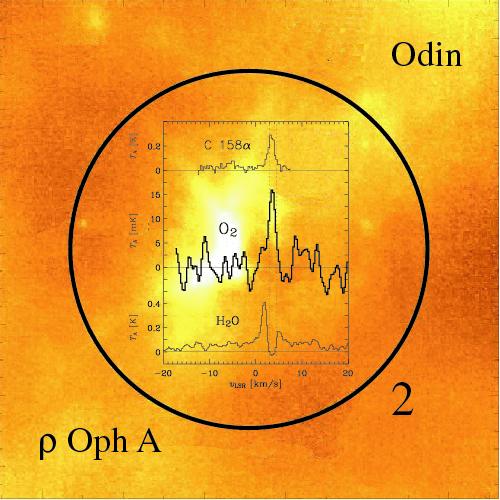
Figure: The molecular oxygen line (middle) appears at the same velocity than the maximum absorption trough of other traces such as H2O (bottom). These tracers have an intense emission coming from the very warm region behind the cloud and this emission is absorbed by the very cold gas of the cloud standing in front. This absorption is therefore a sign of a large quantity of cold gas, which seems to be favorable to the O2 show-up.
Oxygen is the most abundant of all elements not produced during the Big-Bang. As such, simple species based on Oxygen, such as CO, H2O and O2 are expected to be very abundant in the interstellar medium. While CO has been found as early as 1970, and H2O even before in 1968, O2 has remained elusive for 20 years, since the first attempts to find it in 1983. It is a weak emitter, making it difficult to detect but worse, its chemistry is not understood and its abundance, originally thought to be comparable to that of CO, is rather 2 or 3 orders of magnitude lower. We finally detected the ground transition in Rho Oph with the Odin satellite ( in French, or in English. With Herschel, it seems that O2 can be seen in some small spots in warm regions (Orion & Rho Oph at the moment) but its origin and chemistry are still not clear. Work in progress!
See also
Front page News :
Apr 2007 = First detection of O2
PUBLICATIONS:
Chen, J.-H. et al., 2014, ApJ 793, 111 Herschel HIFI observations of O2 toward ORION: special conditions for shock enhanced emission
Melnick, G. et al., 2012, ApJ, 752, 26 Herschel search for O2 toward the Orion Bar
Liseau, R. et al., 2012, A&A, 541, A73 Multi-line detection of O2 toward ρ Ophuichi A
Goldsmith, P.F. et al., 2011, ApJ, 737, 96 Herschel Measurements of Molecular Oxygen in Orion
O18O and C18O observations of ρ Ophiuchi A
Liseau, R., Larsson, B., Bergman, P., Pagani, L., Black, J. H., Hjalmarson, &Aa;
., Justtanont, K. 2010, A&A, 510, A98
Aa. Sandqvist, B. Larsson, Ã
. Hjalmarson, P. Bergman, P. Bernath, U. Frisk, M. Olberg, L. Pagani and L. M. Ziurys, 2008, A&A, 482, 849, Odin observations of the Galactic centre in the 118-GHz band - Upper limit to the O2 abundance
Larsson, B., Liseau, R., Pagani, L., et al., 2007, A&A, 466, 999 Molecular oxygen in the rho Ophiuchi cloud
Wilson, C. D., Olofsson, A. O. H., Pagani, L. et al., 2005, Searching for O2 in the SMC: Constraints on oxygen chemistry at low metallicities, A&A, 433, L5
Pagani, L., et al., 2003, Low Upper Limits on the O2 Abundance from the Odin Satellite, A&A, 402, L77
Pardo J.R., Pagani L., Olofsson G., Febvre P., Tauber J., 2000, Balloon-borne submillimeter observations of upper stratospheric O2 and O3, J. Quant. Spectrosc. Radiat. Transfer 67, 2, 169
Deschamps A., Encrenaz P.J., Febvre P., et al., 1998, A balloon experiment searching for the 425 GHz O2 line with an SIS receiver, ESA Workshop on Millimeter Wave Technology and Applications
Olofsson G., Pagani L., Tauber J., et al., 1998, Low interstellar abundance of O2 confirmed in a balloon experiment, A&A 339, L81
Marechal P., Viala Y.P., Pagani L., 1997, Chemistry and rotational excitation of O2 in interstellar clouds-II : The 16O18O isotopomer, A&A 328, 617
Marechal P., Pagani L., Langer W.D., Castets A., 1997, Searching for 16O18O, A&A 318, 252
Pagani L., Langer W.D., Castets A., 1993, First Tentative Detection of molecular oxygen isotopomer 16O18O in interstellar clouds, A&A 274, L13